You’re probably watching your heating bills climb each winter while wondering if there’s a better way to stay warm without breaking the bank. Your thermostat holds more money-saving potential than you might realize – it’s not just about turning the heat down when you’re cold. The right strategies can slash your energy costs by thousands of dollars over time, and most homeowners haven’t discovered these simple yet powerful techniques.
Program Temperature Setbacks During Sleep and Away Hours
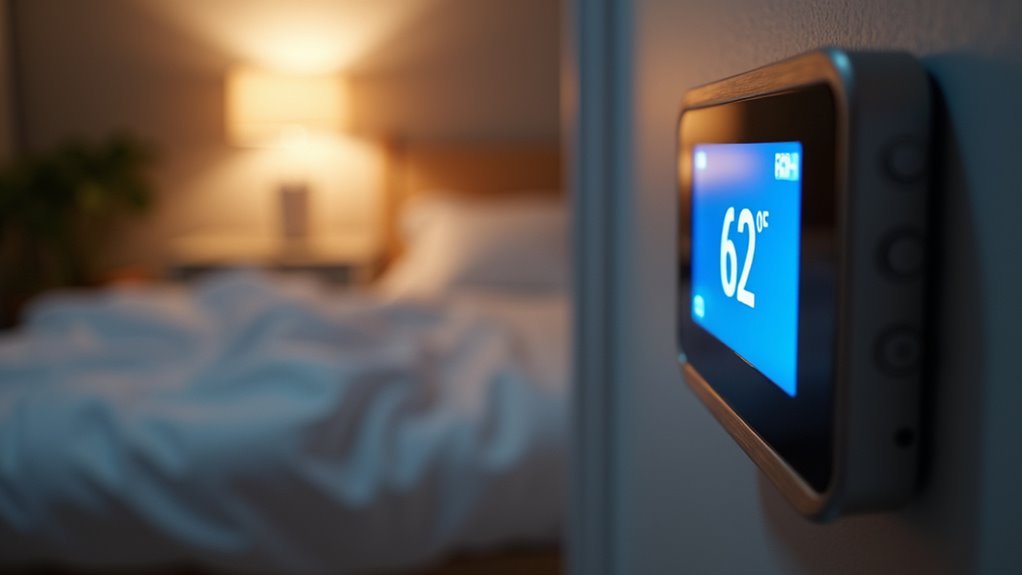
When you’re asleep or away from home, programming your thermostat to lower temperatures by 5-10 degrees can cut your annual heating bill by up to 10%.
To enhance energy efficiency, maintain these reduced temperatures for eight hours or more, particularly during nighttime when comfort isn’t compromised.
Maintaining lower temperatures for eight or more hours maximizes energy savings without sacrificing comfort during sleep periods.
A smart thermostat automatically manages these setbacks, adjusting settings based on your schedule and occupancy patterns for maximum savings.
You’ll achieve better results by making gradual temperature adjustments rather than drastic changes, preventing your heating system from overworking and operating inefficiently.
When you consistently lower your thermostat during inactive hours, you’re not wasting energy heating unused spaces.
This strategic approach guarantees significant cost reductions accumulate over time while maintaining comfort when you’re actually present.
Maintain Optimal 68-70°F Temperature Range When Home
You’ll maximize your home’s energy efficiency by keeping your thermostat between 68°F and 70°F when you’re home, as recommended by the U.S. Department of Energy.
This temperature range provides ideal comfort while preventing your heating system from working harder than necessary.
Even small adjustments matter—lowering your thermostat by just one degree can save you up to 1% on your heating costs.
Department of Energy Recommendations
According to the U.S. Department of Energy, you’ll achieve ideal comfort and savings by setting your thermostat between 68°F and 70°F when home. These guidelines aren’t arbitrary—they’re based on extensive research showing this range maximizes efficiency while maintaining comfort.
The Department of Energy emphasizes that every degree adjustment impacts your energy costs considerably. You’ll see measurable savings with consistent temperature management within their recommended range.
| Temperature Adjustment | Heating Cost Savings | Annual Bill Impact |
|---|---|---|
| 1°F lower | 1% reduction | Minor savings |
| 5°F lower | 5% reduction | Moderate savings |
| 10°F lower | 10% reduction | Notable savings |
Your furnace operates most efficiently within the 68-70°F range, preventing overheating and unnecessary energy expenses while delivering consistent winter comfort.
Save 1% Per Degree
Every degree you lower your thermostat translates directly into a 1% reduction on your heating bill, making the 68-70°F range your sweet spot for winter savings. This simple adjustment delivers immediate financial benefits while keeping your home comfortable throughout winter months.
Lowering the temperature just a few degrees from your current setting can save money without sacrificing warmth. The cumulative effect becomes substantial over an entire heating season, especially when you’re consistently energy efficient with your thermostat management.
Consider these key benefits of the 1% rule:
- Predictable savings: Lower your thermostat 5 degrees and save approximately 5% monthly
- Prevented overwork: Your furnace runs efficiently without unnecessary strain or energy waste
- Long-term impact: Small daily adjustments compound into significant annual savings on utility bills
Utilize Smart Thermostat Automatic Weather Adjustments
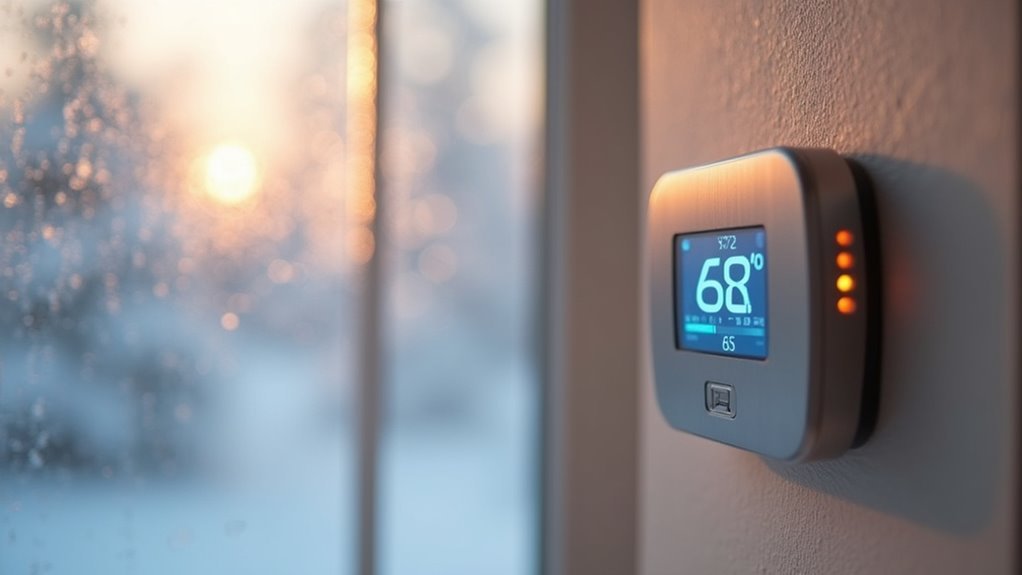
When temperatures fluctuate unexpectedly during winter months, smart thermostats automatically adjust your heating settings based on real-time weather data to maintain ideal comfort without wasting energy.
These devices utilize outdoor temperature forecasts to preemptively lower heating levels during milder days, considerably reducing your energy use.
You’ll benefit from geofencing features that automatically adjust temperatures when you leave or return home, eliminating energy waste during unoccupied periods.
Energy usage reports provide valuable insights into your heating patterns and costs, helping you make informed decisions to save on energy bills.
Remote access through mobile devices lets you respond immediately to unexpected weather changes, optimizing efficiency throughout winter and maximizing your savings potential.
Monitor Real-Time Energy Usage Data for Cost Insights
By tracking real-time energy usage data through your smart thermostat, you’ll gain valuable insights into your home’s heating consumption patterns and identify specific opportunities to reduce costs.
When you monitor this data consistently, you’ll discover exactly when your heating system works hardest and costs you the most money.
Your smart thermostat’s detailed reports show how temperature adjustments directly impact your energy expenses, empowering you to make informed decisions about your heating routines.
- Peak Usage Analysis: Identify high-consumption periods and adjust settings during expensive peak hours
- Cost Impact Visualization: See immediate financial effects of temperature changes through detailed energy reports
- Mobile Optimization: Access real-time data remotely to save money by making prompt adjustments anywhere
This data-driven approach can reduce your energy bills by up to 10% through strategic heating management.
Schedule Multiple Temperature Programs for Different Times
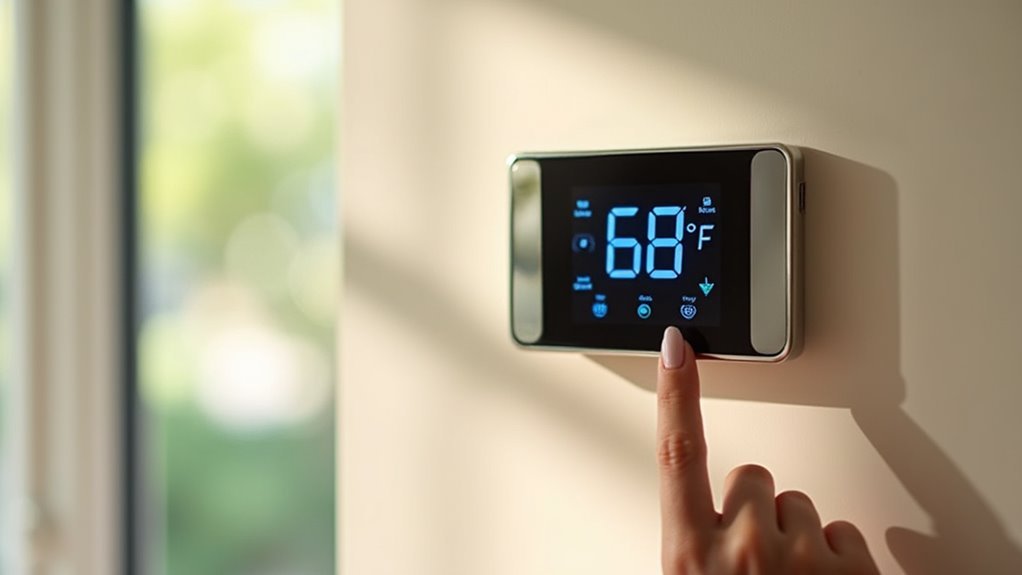
You can maximize energy savings by creating distinct temperature programs that match your daily routine throughout the week.
Set cooler temperatures during morning hours when you’re rushing out and warmer evening settings when you’re home relaxing.
Don’t forget to adjust your weekend schedule since you’re likely home more often, requiring different heating patterns than your weekday programs.
Morning and Evening Settings
Since most families follow predictable daily routines, programming your thermostat with multiple temperature settings throughout the day can slash your heating costs by up to 10% annually.
Your morning and evening thermostat setting adjustments create the most significant energy savings opportunities.
Start your day by programming a comfortable 68°F when you wake up, then automatically drop to a lower temperature around 60-65°F when you leave for work. As evening approaches, you’ll want your system to warm the house before you return home.
Key morning and evening programming strategies include:
- Set gradual temperature increases 30 minutes before you typically wake up
- Program automatic decreases within an hour of leaving home
- Schedule evening warm-up to begin 15-20 minutes before your usual arrival time
This approach maximizes comfort while minimizing energy waste.
Weekend Schedule Adjustments
While weekday programming focuses on work schedules, weekends require a different approach since your home activity patterns shift dramatically. You’ll need to set the thermostat for different weekend routines compared to your Monday-through-Friday schedule. Smart programming can save you money by automatically adjusting temperatures based on when you’re typically home or away during weekends.
| Time Period | Recommended Temperature | Energy Savings |
|---|---|---|
| Saturday Morning | 68-70°F | Moderate |
| Weekend Afternoon Out | 58-62°F | High |
| Evening Home | 68-70°F | Moderate |
| Weekend Night | 60-65°F | High |
| Sunday Recovery | 65-68°F | Moderate |
Avoid Extreme Temperature Settings That Waste Energy
When you crank your thermostat above 70°F during winter months, you’re fundamentally throwing money out the window, as heating costs climb by approximately 1% for every degree beyond the recommended 68°F to 70°F range.
Many homeowners mistakenly believe cranking temperatures higher heats homes faster, but this strategy backfires spectacularly.
When you set your thermostat to extreme settings, you’re forcing your HVAC system into overdrive without any speed benefits.
Smart temperature management involves three key strategies:
- Lower the temperature by 5-10 degrees when sleeping or away for up to 10% annual savings
- Maintain moderate settings to prevent system strain and costly repairs
- Avoid frequent extreme adjustments that decrease equipment lifespan
These simple changes help save substantial money while maintaining comfortable indoor conditions throughout winter.
Use Remote Mobile Access to Prevent Unnecessary Heating
Smart thermostats equipped with remote mobile access transform how you control heating costs by eliminating unnecessary energy consumption when you’re away from home. You can adjust temperature settings from anywhere using mobile apps, ensuring you’re not heating an empty house.
Real-time energy monitoring helps you identify usage patterns and make smart decisions about your heating schedule. These devices automatically detect when you’re away and adjust accordingly, providing both convenience and efficiency.
You’ll save up to 10% on annual heating bills by preventing unnecessary heating cycles. Programming multiple schedules through your mobile device lets you align energy use with your lifestyle, reducing waste while maintaining comfort when you’re actually home.
Combine Lower Settings With Proper Home Insulation
Because proper insulation works hand-in-hand with thermostat settings, you’ll achieve maximum energy savings by combining both strategies effectively.
Maximum energy savings come from pairing proper insulation with smart thermostat settings rather than relying on either strategy alone.
When you maintain a comfortable 68°F setting with quality insulation, you’ll reduce heat loss and cut energy bills by up to 10% during winter months. This combination guarantees your heating system retains warmth longer, supporting consistently lower thermostat settings.
The U.S. Department of Energy recommends lowering your thermostat 5-10°F at night or when away, but proper insulation makes this strategy truly effective:
- Seal air leaks around windows and doors to prevent drafts that increase heating demands
- Invest in quality insulation to enhance energy efficiency and heat retention
- Perform regular maintenance to prevent costly heat loss and maintain comfortable lower settings
Prevent Overheating Through Gradual Temperature Changes
You’ll cut energy costs by avoiding extreme temperature swings that force your heating system to work overtime.
Instead of cranking the thermostat up high hoping to heat your home faster, set it directly to your target temperature between 68°F and 70°F.
Making small, gradual adjustments of just one or two degrees can save you approximately 1% on heating costs for each degree you lower.
Avoid Extreme Temperature Settings
Although cranking your thermostat to extreme temperatures might seem like the fastest way to warm your home, this approach won’t actually heat your space any quicker and will drive up your energy costs unnecessarily.
Your furnace operates at the same speed regardless of how high you set the temperature, making extreme settings counterproductive.
When you avoid extreme temperature settings, you’ll maintain consistent comfort while reducing strain on your HVAC system.
Consider these benefits of maintaining a moderate temperature:
- Lower energy bills through reduced system workload and improved efficiency
- Extended equipment lifespan by preventing excessive wear from overworking
- Consistent home comfort without temperature fluctuations that waste energy
The Department of Energy recommends keeping your thermostat between 68°F and 70°F for peak efficiency and cost savings.
Set Target Temperature Directly
Setting your thermostat directly to your desired temperature prevents the common mistake of cranking it up high with hopes of faster heating. Your furnace doesn’t operate at variable speeds, so setting it to 80°F won’t heat your home faster than setting it to 70°F—it’ll just overheat and waste energy.
The U.S. Department of Energy recommends maintaining an ideal thermostat temperature between 68°F and 70°F. When you need adjustments, make gradual changes of 1°F to 4°F increments. This approach helps your heating system operate efficiently while preventing strain and energy waste.
Since heating accounts for over half of residential electricity consumption, avoiding overheating can cut your energy bills considerably.
Consistent temperature management will save you energy and deliver up to 10% savings on annual heating costs.
Small Adjustments Save Energy
When making temperature adjustments, even a single degree change can considerably impact your energy consumption. Gradually lowering your thermostat by just 1°F can save you up to 1% on your heating costs, making small adjustments a powerful strategy for reducing both energy and money expenditures throughout winter.
Your heating system operates most efficiently when you avoid drastic temperature fluctuations. Don’t increase temperatures dramatically thinking it’ll heat your home faster – thermostats don’t control furnace speed, and such changes lead to higher utility bills.
- Lower temperatures by 7-10 degrees when sleeping or away for 8+ hours
- Maintain the recommended 68°F setting to prevent overheating
- Make gradual one-degree adjustments rather than dramatic temperature swings
These consistent practices help your system run efficiently while maximizing savings.
Maximize Annual HVAC Maintenance With Smart Monitoring
Most smart thermostats don’t just control your heating—they actively monitor your HVAC system’s performance and send you timely maintenance reminders.
These devices track your energy usage patterns and can detect when your system isn’t operating efficiently, alerting you to potential issues before they become costly problems.
Frequently Asked Questions
How Can I Lower My Energy Bill in Winter?
You can lower your winter energy bill by setting your thermostat to 68°F when home, reducing it 5-10 degrees when away, sealing drafts, maintaining your HVAC system, and using programmable thermostats.
Is It Cheaper to Leave Your Thermostat at One Temperature?
Yes, maintaining one consistent temperature is typically cheaper. You’ll avoid energy spikes from your system working harder to reach drastic temperature changes, reducing wear and preventing unnecessary consumption that increases bills.
What Temperature to Keep a House in Winter to Save Money?
You should set your thermostat to 68°F while you’re home during winter. Lower it by 7-10 degrees when you’re sleeping or away for at least eight hours to save money.
What Is the Cheapest Temperature Setting for Winter?
You’ll save the most money by setting your thermostat to 58-62°F when away or sleeping, but don’t go below 55°F to prevent pipe freezing and costly repairs.

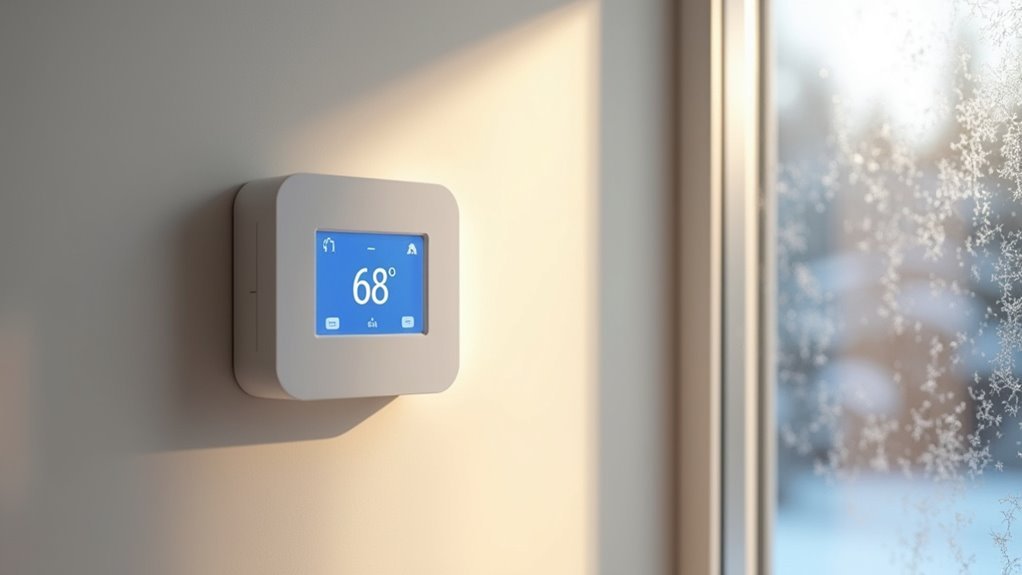
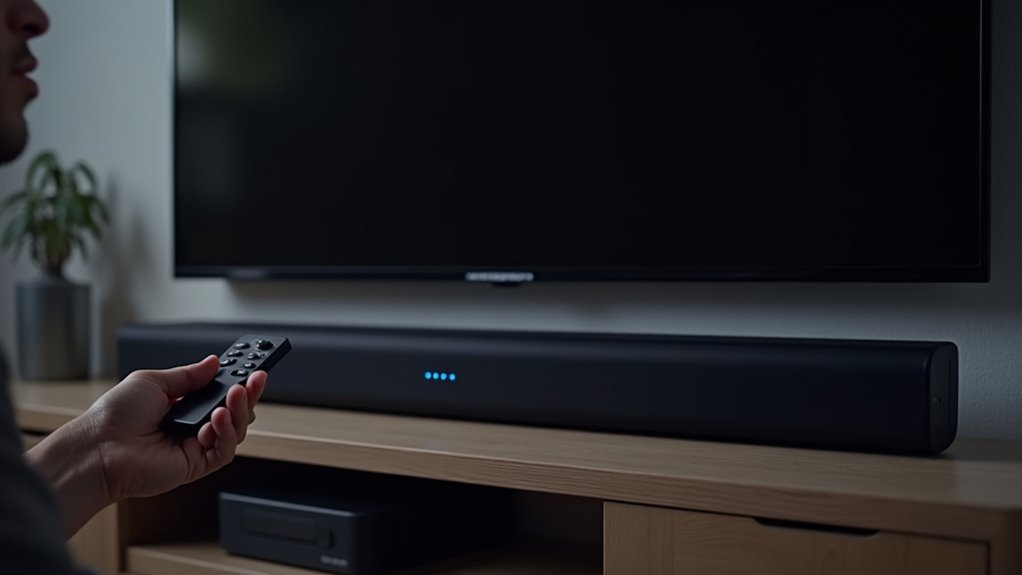
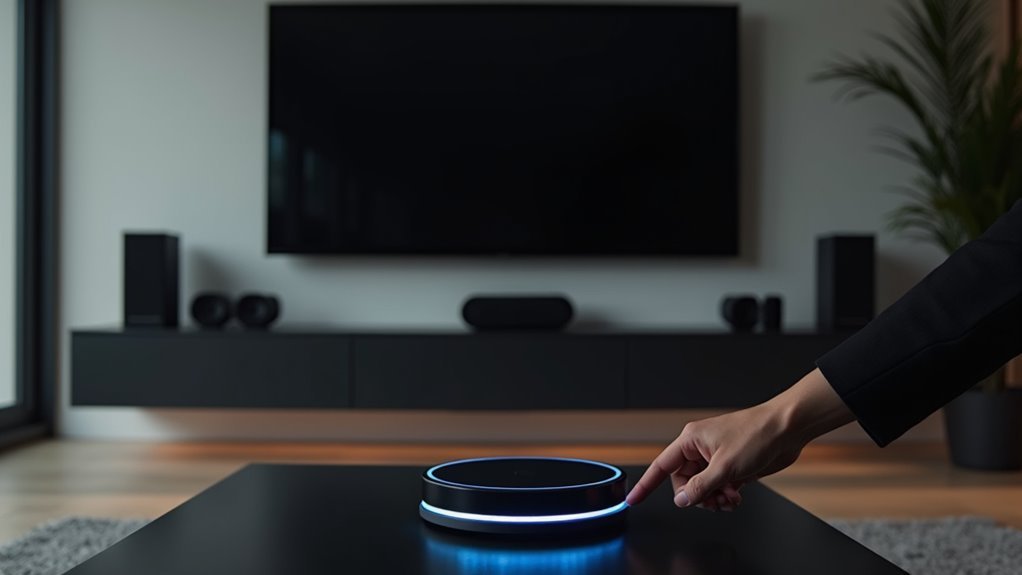

Leave a Reply